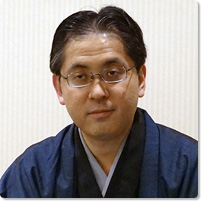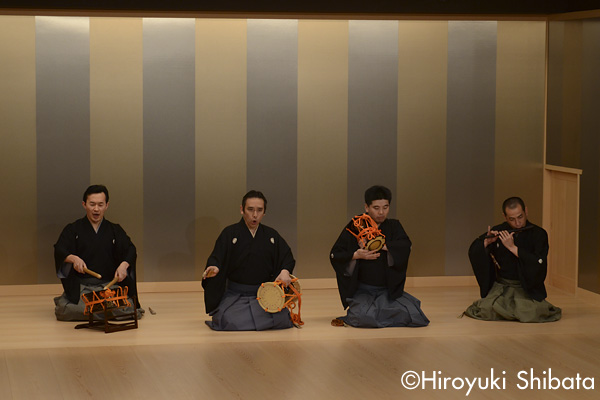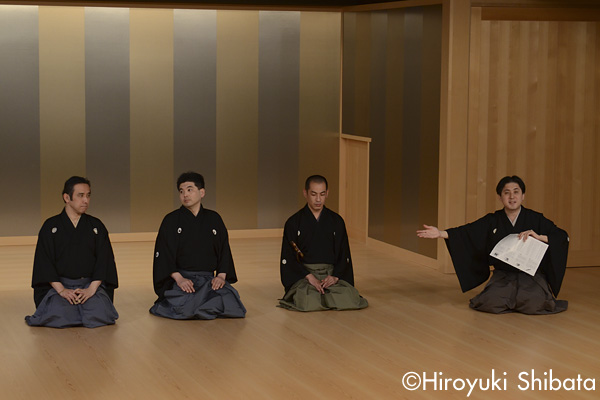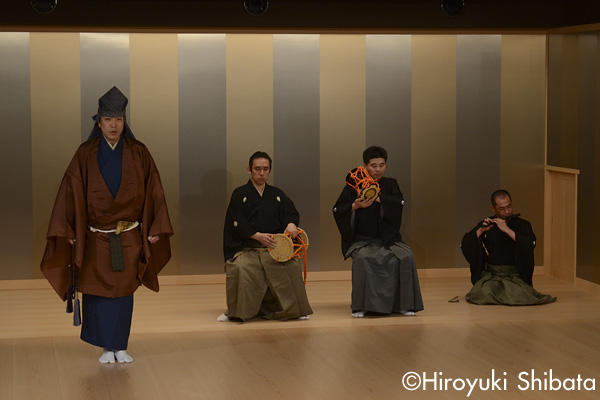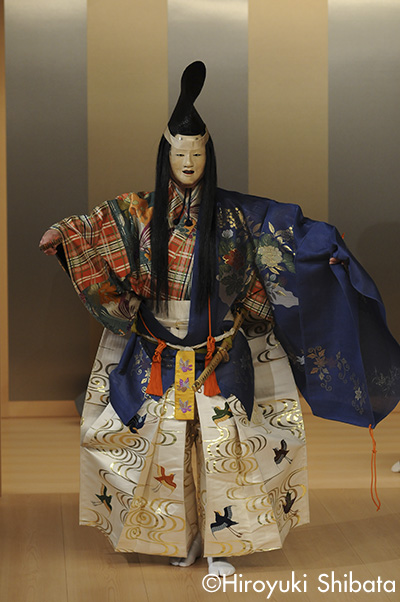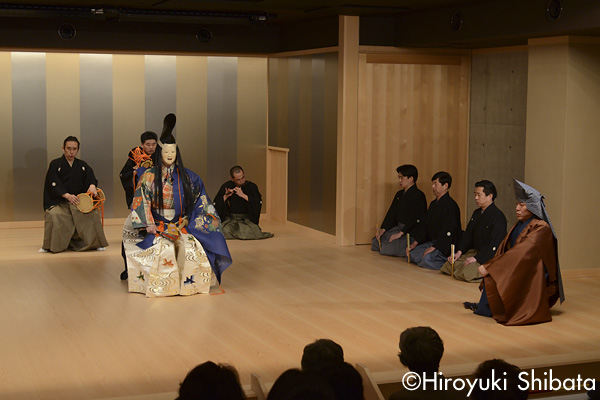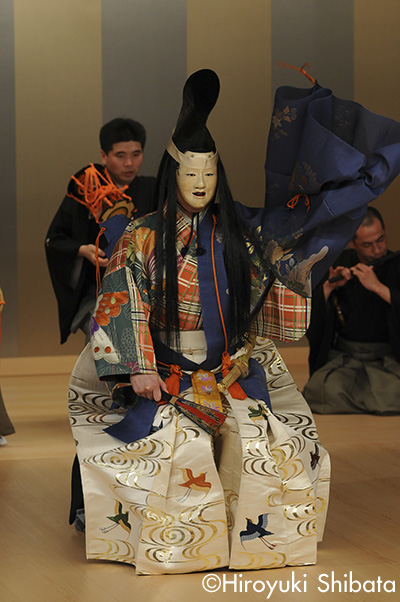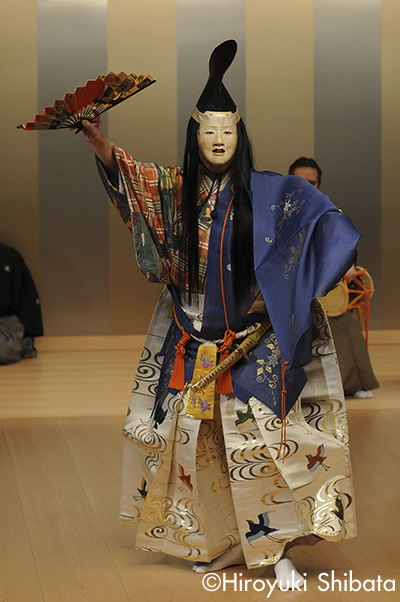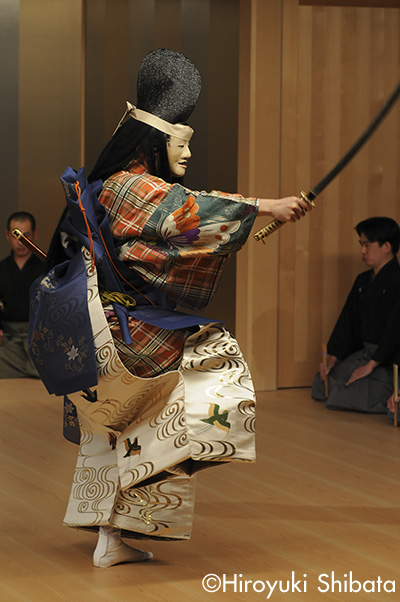- For the shite-kata actor who plays the main role in a Noh play or recites in the Noh chorus ( ji-utai ) there are five traditional schools, the Kanze, Hosho, Konparu, Kongo and Kita schools. When we hear the family name Kanze, anyone with even a little knowledge of the traditional performing arts knows that it is the name of a Noh performer.
- In Japan today there may not be many people who associate a family name with Noh anymore. When I give people my business card, most are surprised to see that Kanze is my actual family name. I think this is because in the performing arts, including the traditional arts, it is more common to go by an [acquired] artist’s name rather than your actual family name. But, in the world of Noh almost all of us go by our actual family names.
- So, does being born into the Kanze family mean that you are fated to become a Noh performer?
- Noh has always been a world where the sons inherit the family art. I have three older sisters, and as the fourth child I was our family’s first son. So, I was told from the time I was a child that I would be the heir to my father’s art, and everyone in our family assumed that I would. However, recently there are a growing number of women Noh artists and I feel that the trends of the times are changing.
- So, were you raised differently from your sisters?
- My oldest sister is 12 years older than me and the youngest is eight years older, so I don’t really have a sense of how they were raised compared to me. It may sound rather old-fashioned in our times, but from as young an age as I can remember I was sitting next to my father at meals. So, even though I was the youngest in our family, I was seated in the position of seniority above my mother and sisters at the family meals. As the youngest child I was spoiled quite a bit, but when it was time for my daily Noh training, I knew from a young age that I had to behave and obey every instruction.
- From what age did your Noh training begin?
- I don’t know (laughs). In other words I was too young to remember. I know that I was two and a half when I first performed on stage. There are photographs and a tape with my voice reciting my part in the play, but of course I was too young to remember any of it. I do remember performing Hashi Benkei with my father at my nursery school graduation, however. That would mean the spring when I was five years old. And, before that I have fragments of memories of myself performing as a ko-kata (child actor) and in shimai dance performances, but I don’t remember what age I was.
- In the case of the child roles in Noh, called ko-kata , is it common for both boys and girls to perform on stage for the first time between about the age of three and he end of elementary school age? Also, besides the chigo (child roles), it is a convention of Noh to have children perform adult roles as well. It is so adorable to see children acting diligently and patiently throughout a long Noh performance, and it invariable creates a sensation among the audience.
- My earliest clear memories of performing ko-kata roles were from after I entered elementary school. For me as a child, I only knew that training for Noh performances was something that I had to do, just like going to school. And I was made to train with particular focus when we were preparing for a specific role I had been given in a performance. I am often asked how many hours a day I practiced, but in fact, my father was very busy at the time, just like I am now, so he often wasn’t at home to train me. So, it wasn’t as if I had set practice times every day. For example, when I was given a child ( ko-kata ) role like Funa Benkei for a performance, I would be given lessons to train for that role. These role are decided about one year in advance, so my father would decide how the training would proceed, and then begin with teaching me the utai (recitation) part. There are six places in Funa Benkei where the child actor has a part to recite, and I would be taught these parts orally by repeating after my teacher (my father). Around the time when I would have the utai parts memorized, my training in the movements on stage would begin. For example, one type of movement I would have to learn was like a sword fight, and I would be shown the movement for that and practice it with my father. When I began to memorize the movement that way, I would next be told to try it by myself. When I ask other Noh actors, it appears that most of them spent more time practicing than me. So, looking back, I guess I had a fairly easy time compared to most.
- So, it appears your father believed that, with a young child at the age where he wanted to be out playing with his friends, it was as better to practice a little at a time when there was a specific role to perform, and then have the child see the results of the effort in the actual stage performance.
- From a certain age there might be a different form of practice, and I believe that is something I have to think about and do with my own children. Also, I should mention that while I was in elementary school I was being taught the fundamentals of the large and small tsuzumi hand drums, the flute and the stand drum by other teachers as well. The small hand drum has to be held as you play it, so those lessons didn’t start until I was a bit older. But, by the first grade of elementary school I had begun the three instruments, and to be precise, I began the stand drum when I was still in nursery school. I don’t know if you could call it formal lessons, but I have memories of sitting on master Toyoji Kakimoto’ knees and calling out “ Tsuku tsuku, Yo ” in time with the drum beat as I practiced.
- That’s shoka (traditional singing), isn’t it? Not only in Noh but in all the traditional Japanese performing arts, before a young apprentice actually starts playing an instrument they practice the melody or rhythm vocally, using onomatopoeia. In the case of the drum they vocalize the rhythm with the sound “ teretsuku ” and with the flute they use the sound “ ohyari ” and such. If your father was exposing you to that kind of training from your nursery school days, it sounds like he intended to train a child prodigy.
-
When I was a in the first grade in elementary school I was told one day to go to the dressing room backstage at the [Noh] theater. When I arrived I found the large tsuzumi drum (
oh-kawa
) master Takeo Yasufuku waiting with copy of the Takayasu school drum textbook for beginners and he had me start learning with the vocal rhythm calls, “Hai, Yo-.” For the flute, I was taught by master Yoji Isso. Apparently master Isso had a difficult time teaching such a young child. We still have the tape he made for me to practice from with repetitions of very short drum phrases. Apparently I was told to listen to that tape, but I never did. If I was interested in something, I did it diligently, but in this case it wasn’t until a couple of years later that I was told, “Yoshimasa-kun, next time memorize the rhythm before you come to practice,” and only then did I realize that I was supposed to memorize the drum parts (laughs).
Perhaps you could call it a matter of integrity, but my father believed in always having me learn properly from top professionals from the very beginning. I think that is a fine stance, but I’m sure it would have been easier for the teachers if he had waited until I was a little older. - Although you say you were to young to practice properly, certainly there were important things that you were absorbing physically, even if you weren’t consciously aware of it, weren’t there?
-
Yes, and in that sense I am grateful now that I was put in such a learning environment. Because I had these top-level performers struggling to teach this little child. For example, in the play
Tsuru-kame
the child actor has to dance a part called
Chu no Mai
, and for that dance you have to take your cues from the flute part. One could probably learn it from listening to a tape, but having been taught musical accompaniment (of the drums and flute) certainly helped my dance.
The ko-kata child roles in Noh actually make for an excellent education system. Because if the child is going to perform on stage in one of these roles, they naturally have to do the necessary training and practice. There are about 40 Noh plays performed today that have child parts, which means about one in every five or six of the current repertoire of plays. That means there are a rather large number of opportunities for the children of shite-kata (lead role performers) to perform on stage. In comparison, there are no opportunities for the children of waki-kata (support role performers) to have a role in a play. However, with the lower birth rate in recent years there have been an increasing number of cases where the children of hayashi musicians and waki-kata performing ko-kata roles. The play Kurama Tengu has roles for several children, which makes it an ideal play for having a number of children of the same age practicing together, regardless of their differing roles. By the way, there are many child roles in Kyogen (the comic counterpart of Noh), but in the case of hayashi-kata musicians the children have to be big enough to hold the instruments, so they don’t begin performing on stage until a later age than shite-kata children. - I am always amazed when I see the children in ko-kata role sitting (still on the floor in formal posture) through the long Noh performances lasting nearly two hours even though their actual recitation or dance parts are quite short. It is something that is difficult even for adults.
-
I don’t remember what age I was when I became able to bear those long sits. My own child is now 18 month old and finally just able to walk around, but in two or three years he will have to be performing child roles on stage. So, I am already starting to worry about how I will train him to sit for an hour (laughs).
The way my father taught me to do child roles was to have me sit on the stage throughout the performance waiting for the place where I would have my recitation part and then continue sitting after my part was finished waiting for the waki role teacher to come and help me to stand up and leave the stage. Since the performances are long, I would be sitting there with my head nodding sleepily at times and twisting and squirming other times. However, a child’s ability to concentrate is a mysterious thing, and by being taught what parts I was to chant in, I would be ready when that part came and do it.
Actually, when I described this teaching method of my father to another shite-kata he was very surprised. He said he grew up believing that sitting through the whole rehearsal was the way it was done, because that is the way he was taught. You go on stage, sit and watch your father’s long dance and when your part comes you recite or dance and then sit again. He said the rehearsals would be an hour or an hour and a half, the same as the actual play performance. My father only taught me the essential parts for my role. About the only thing I ever recall being instructed to do was to sit quietly and not to scratch even if I felt an itch. You could say it was not much in the way of teaching, but I do believe it was practical perhaps. My father said that children don’t have patience, so you have to get their training over with as soon as possible, and that scolding them would only make them hate practice, so don’t scold.
When I teach other people’s children I realize that indeed their attention span is short. They will only listen to you for about ten minutes. When I see that they have lost interest I say, “OK, we will learn the rest next time. So, go back and practice what we did today until you learn it.” That makes their parents nervous. But when it comes time for the stage performance, the children always do their part well, which makes me think that maybe their parents are making them practice for me. - Is it correct to believe that performing ko-kata child roles makes children absorb Noh naturally?
- Well, yes. In many plays the child may just be sitting there on the stage for 30 minutes or an hour, but just being there on stage naturally teaches them the unique time flow of Noh. In the play Sakuragawa there is not even a single recitation part that the child must do. They just sit there. Still, I had to practice for it. It is practice in going on stage, sitting and then standing when told. That practice may last for just ten minutes, but in the actual performance of the play you have to sit for an hour.
- When boys reach middle school age they begin to grow rapidly, their voice changes and such, so it becomes difficult for them to continue doing child parts, doesn’t it?
- At that age they no longer get child roles. But, things work out well because at that age they have been learning hayashi (musical accompaniment) for five or six years and have begun to understand the reasoning behind the things that are happening, which makes practice more interesting for them. They also become able to read the Chinese characters in the recitation text that they couldn’t read when they were in elementary school, so you become able to follow the text as you practice with your father. When you reach that stage, you also become able to understand the symbols that are written beside the characters, so you can begin practicing by yourself and Noh gets more and more interesting to you.
- About what age were you when you became aware that you were becoming a Noh performer?
-
Around the time I was in my third year of middle school I would be sitting there as a member of the
jiutai
(the Noh chorus) in the Sunday performances. By that time I was able to memorize the recitations and sit in the formal
seiza
position for an hour and a half or two hours along with the other adults, which made me want to work harder at it. I began helping out in the performances put on by the Kanze Kyukokai that my father led, and I would go along with them to performances around the country. At that point I had a vague feeling that I would become a professional Noh performer, but it wasn’t really clear in my mind. I had been told that I should keep going to school, so I assumed that I would be going on to university like my friends. At university I majored in political studies in the law department, which turned out to be a good thing for me. It broadened my perspective to things beyond the world of Noh.
During my university years I was performing in the Noh plays on Saturdays and Sundays, and at the risk of causing misunderstanding, I would say that it felt to me like a kind of side job. However, when I got into my third year of university and my classmates were beginning job hunting, I ended up spending less and less time with my good friends. When I thought about what I could do, I found that I had nothing except Noh. Around the time I began to think that way, some of the older Noh artists began asking me to come along when they went drinking, like whispers from the devil perhaps (laughs). After that I began spending more and more time with the other Noh artists and began to accept the fact that I would become one of them. - It seems as if those older Noh artists had been watching for the time to draw you into the flock, hadn’t they?
- That may be true (laughs). But, it was as if I wasn’t thinking about the choice before it happened. I was thinking about what I could do if I became a Noh performer at that time when I still didn’t have a solid base in the art. I was thinking that if I was going to make it my profession I wanted to do it with some purpose in mind. Noh being one of the staid old traditional arts, I worried whether I would still be able to make a living at it ten years or so down the line. So, I decided that I wanted to try to change that situation.
- About 20 years ago there were lots of Noh events like nighttime takigi Noh performed by firelight, not only in Tokyo and Osaka but in the regional cities as well. Still, you were pessimistic enough to worry that in ten years you wouldn’t be able to make a living with Noh?
-
That was the time of Japan’s economic bubble when the economy was booming and there were plenty of
takigi Noh
(outdoor Noh performance on summer night) events and such around. It was a time when even we young performers who couldn’t do much of anything as artists could still get in a car, go someplace and put on something that looked like Noh. I thought that wasn’t a good thing. I felt that the way Noh was presented at that time didn’t involve much communication between the audience and the performers. It was out of sync with the audience. As I was performing I was thinking, “Are these acoustics really OK? Is this lighting OK? Are we doing enough?”
At the time, the Kanze Kyukokai’s standard performance programs were either of a Noh Sanban (“third category” Noh plays in which the central character is a god in the form of a woman) or a combination of a su-utai (Noh recitation without musical accompaniment ) and Noh Niban (“second category” Noh plays with a male central character in the role of a warrior). Teaching amateur apprentices is an important job of a shite-kata Noh artist. Because increasing the number of apprentices directly connects to increase in the overall size of the Noh audience. A third category Noh play performance is probably fine for people who have some experience learning Noh recitation ( utai ) and dance ( shimai ), but it is too heavy for someone who is seeing Noh for the first time. There are many people who say they want to see Noh, but the programs usually being presented are not suited for that novice audience. When I was young I felt a vague discomfort with that atmosphere of Noh being performed only for the Noh circle. Also, around that time the circle of amateur apprentices who supported the Noh were getting older and some of the major figures of the Noh world were passing away, and some of the regional Noh studios had begun to disappear. When performances were held they would often be full of empty seats. All of this made me wonder what would be left ten years later and gave me the feeling that I had to do something about it. - Did other Noh performers of your age feel the same way?
-
It was talking with Noh friends of my generation who felt the same way that led to the start of our “Kamiasobi” (gods play) group activities. What started it was the feeling we got from our experience with nighttime
takigi Noh
that we needed to gain more confidence in art, and we started with
hayashi-kata
musician work (practice) sessions. At the time, we wanted to apply ourselves to more difficult works than we usually performed, so we asked Master Gensho Umewaka, the late Master Tetsunojo Kanze and other masters from other Noh schools to teach us. After continuing those study sessions for several years a core group began to take shape, and since there were some theaters that took an interest in our performances as a unit made up exclusively of younger generation Noh performers. So we started activities as the “Kamiasobi” group consisting of flutist Takayuki Isso, Hirokazu Kakihara on the
oh-kawa
hand drum, Motonori Kanze as the
taiko
standing drum player, Shinkuro Kanze on the
ko-tsuzumi
hand drum and myself.
The concept behind our Kamiasobi activities was to offer three types of performances, ones complete with explanations that made them easy to understand for beginner Noh audiences, events like our “candle Noh” performed to candlelight and true Noh performances in the traditional style. Our first performances were in 1997, so it has been 15 years. We were in our mid-20s when we started and now we have all reached our 40s. - Watching your Kamiasobi performances over the years there seem to be changes in your style, aren’t there?
-
Gradually we have all become busier, so we have reached the conclusion that we can leave the audience-building type performances to performers of the younger generation. In the “No-u, No-u, Noh” performance series with full explanations for beginning audiences that I started, I have continued to show the audience things like how the Noh costume is worn and give explanations of things like the background behind Noh.
The true formal Noh performances in the traditional style that we give have continued at a pace of about one a year. Although we are still lacking as artists, we attempt to present difficult works like Kinuta, Koi no Omoni (Burden of Love) and Sotoba Komachi . For a looking time we had also been saying that we wanted to try doing new contemporary Noh works, and in 2008 we finally did one. It was Bakuryu – The Malt Whisky Story , but unfortunately we had no requests for repeat performances of it (laughs). To celebrate Kamiasobi’s 15th year in 2012, we plan to prepare an especially fruitful production. - Bakuryu is a rare work telling the story of the birth of malt whisky in Scotland, and, with the name “No-u, No-u, Noh” that combines the no-u, no-u chant of the shite actor and the mission to help people “know Noh,” I felt was certainly a project worthy of new-generation Noh artists. This No-u, No-u, Noh and the “Ichi kara Hajimeru Keiko Utai, Shimai” (Starting Noh recitation and dance lessons from step one) have certainly been important in helping to broaden the audience base for Noh, haven’t they?
- Entering the 21st century, it became apparent that a lot of people wanted to take lessons in Noh recitation and dance. In any era there were always a lot of people who said that they wanted to see Noh play once. I believe the rise of the desire to try taking lessons in Noh was influenced by the larger “Wa (things Japanese) Boom” rise in interest in things like kimono and other aspects of traditional Japanese culture. Learning Noh utai (recitation) and shimai (dance) is usually done in individual lessons and the only places where it was done as group lessons were places like (adult education/hobby) culture centers. For people who just want to try it to see what Noh training is like, it is difficult to ask for individual lessons, so I thought that in order to build the base of Noh fans it was necessary to provide a more approachable form of initiation to the art, and that is what led me to start group lessons. That was the start of our “Ichi kara Hajimeru Keiko Utai, Shimai” (Starting Noh recitation and dance lessons from step one) that my wife and I planned and publicized all by ourselves. We publicized it in a number of media like fold-in newspaper inserts, leaflets and on my website. It was very well received and attracted many participants, which made us certain that there was a real need for this kind of program. In the past I was always asked where I practiced Noh, but now with the spread of the internet even the staid old art of Noh is easy to find out about on the internet. Now myself and other Noh artist are sending out information about Noh regularly on the internet.
- With your activities to spread the audience base for Noh and your pursuit of your own art, even two bodies wouldn’t be enough, would they?
- Now that I am over 40, I tell myself that I want to cut down on other activities and focus more on creating truly good stages. My father has also gotten old, so it is time for my generation to assume the responsibility of presenting quality Noh performances. If we don’t create the stages where we can really perform well, we will soon lose our foundation. Now is the time to go back and restage the works that we were able to do the recitation and dance for without much preparation and do them again with more thought and preparation to raise the quality of the stages. That is the way I want to spend most of my time from now on.
- What’s more, it is also your responsibility to train the next generation of performers, isn’t it?
-
That’s right. I always have that in mind in my activities. In my generation, there were still a few Noh artists who reached the point where they could stand alone in their mid-20s, but today most do not reach that stage until they are past the age of 30. In the society at large a man has to be able to support a family by the time he reaches 30, but in the world of Noh a 30-year-old is still just a novice.
The reason is that the vast majority of Noh performers today don’t really enter the world of Noh until they have completed college. In the past they told young people, that there was no need to go to college, they should just concentrate on Noh. Today, however, young people are told that they should at least go to college first. Even if they go to an arts college, in the case of the Kanze school, graduates are still treated just like graduates from academic universities. In order to be considered a pro, they have to train for five years after graduation as a live-in apprentice ( uchideshi ) of a Noh master. After that they have to participate in study groups and such before they are considered a pro, which means they are 27, if everything goes smoothly. If they spend another year as assistant to their master, they are then 28. To become a shite takes another one or two years of experience, so they are already 30 at that point. Working on stage for another five or six years gets you to the point where you can finally take on responsibility for stages of your own. To avoid taking that long, we may have to re-think our Noh education system.
For example, when I taught at the Practice Performing Arts School of Singapore (PPAS), a bearded Indian student asked me very sincerely if he could become a professional Noh performer if he tried, but we don’t have any education system for foreign students in Noh. It is not because we reject foreign students, but the Kanze system of having young people spend five years as a live-in apprentice at a master’s home, simply isn’t conceived with foreigners in mind. - How did you teach the students at PPAS?
-
The students were aspiring theater professionals and actors from around Asia with very high levels of focus and physical talent, and they came with high expectations of me as a teacher. I was asked immediately what the concept of
Johakyu
(Introduction, development, climax) in traditional Japanese performing arts meant. So, I had to take a completely unexpected approach of not only explaining the meaning of the words but showing how it is applied in practice. They said that since Noh has been around for 600 years it must have some mystical techniques that no other art has. Someone said it must be in the “Yosshi” call and they wanted to master its secret. When I told them that Noh wasn’t like Chinese kung-fu and there were no such secret moves, they didn’t believe me. They kept asking, full of interest and respect, and insisting that there had to be some secrets.
They naturally think there is meaning to what we are doing, so they ask the meaning of a particular movement. In fact I had just stumbled on a slight rise in the floor, but they don’t miss a thing. Places that a Japanese audience would overlook in the overall flow of things, the foreign students notice and ask about, so I have to say, “That was just a mistake.” If I tried to explain it away, saying it as part of my acting, one lie would lead to another and I would end up in a corner I couldn’t explain my way out of.
I was teaching it as a 3-month course, but since I had responsibilities with Noh performances and meetings back in Japan, I taught it in 2-week sessions. At the end of the course we gave an original performance that was a collection of Noh segments. For the recitation we put notation over the Japanese text in Roman letters they could read the sound from and the recitation was done in Japanese. They listened to the Japanese tapes over and over and we practiced for five or six hours a day, so after two or three days they were able to do the recitation. It was just a 3-month project but I would like you to have seen how good the dance of the better performers was at the final performance.
So, this leads us to the question of what we do if we have foreigners who are really captivated with the art of Noh, are able to master the Japanese pronunciation and want to become Noh performers. In fact there are now a lot of foreign wrestlers in the national sport of Sumo wrestling. On the other hand, there are also many Japanese performing at the top level in Western classical music and ballet. So. I believe this is an issue we will with in the near future. It is another form of “Black Ships” that are approaching from abroad. If enough people with the physical capabilities and power of expression come in from abroad they might take over. The question of whether we accept foreign performers or reject them for the lack of a system to accommodate them is a question that my generation of Noh artists must find an answer to. - Just like America’s Commodore Perry came in his “Black Ships” and forced the Edo Bakufu government to open Japan to trade at the end of the Edo Period, it may not be long before we see the advent of foreign Noh performers. That would certainly be a big change, but then again, the lifestyle of the Japanese has already changed a lot. In our daily lives most of us use tables and chairs rather than sitting on tatami mats in the seiza position, and many Japanese children today have long arms and legs like Westerners. These changes represent a big problem in terms of preserving the style and beauty of Noh as it has been performed until now on the roughly 6-meter square stage of Noh.
-
I am 20 centimeters taller than the average height of Japanese men of the Edo Period, which makes me about as tall as a Noh performer can be without having real difficulty. My father’s shoes are 23.5 or 24 cm, but today 27 cm is normal. When you reach a tall body proportion where your head is 1/9th of your height, we come to a point where the traditional Noh mask (
omote
) may no longer be large enough. Traditional masks and fans are already a bit too small for me, so I order mine made slightly larger, but it seems that “slightly larger” is the most difficult order for the mask makers.
Of course people come in all sizes, large and small, fat and thin, but the old solution is that those differences don’t matter as long as the actor is able to achieve the Noh mood. It is not a case of simply having large people act the role of [the large warrior] Benkei and small people the part of [the lady] Shizuka Gozen. If you are a true Noh artist you have to be able to act both roles. With the Noh mask and the Noh costume on, a small person of just 150 cm tall can still go out on the stage and look the part of Benkei. Conversely, it is alright if a large person [acts the role of Shizuka Gozen] as long as they are able to look lovely and demure. That is probably where the lifeblood of the art is to be found. Stated in the extreme, a Noh artist is certainly of the highest grade if he is able to dance without the mask or the Noh costume and still look like Shizuka Gozen or like Benkei. What’s more, you could probably say that Noh is inherently an art where you don’t really strive to reach that state but it just flows naturally from you when you reach the age of 60 or 70. This is a quality that can’t be quantified and an aspect that can’t be explained in terms of Western style logic. - You have just entered your 40s. There must be a number of ideas you want to try from now on to make Noh a more familiar art form, aren’t there?
- I have been saying for a while that I would like to have Noh performed on a daily basis the way Kabuki is.
- We think of Noh as an art of single performances and an art that values the importance of a single encounter and moments that we share only once. Since Noh productions involve only one performance, it is often hard to get tickets, and there are few performances to begin with.
-
Some people say that if Noh plays were performed day after day the quality of the performance would decline, but I think it would be the best environment of all if Noh was performed daily and audiences could come to see it anytime. I would like to have people see the plays not just once but several times. I think Noh has the depth for that kind of repeated viewing. I still haven’t found a producer willing to that kind of performance run, but if performances were held on a daily basis we could get feedback from the audience that could provide us with hints to make meaningful changes in our performances.
My generation of Noh artists haven’t had many opportunities to perform overseas, but since Noh is highly acclaimed overseas, I would like to think from now on about how we could give quality performances abroad in Asia and other regions. What plays would be best? How would we use the theater space? How to translate the plays, or whether it is best not to translate them. If we had the opportunity to go to some overseas arts festivals year after year, it would be a good way to show foreign audiences a variety of different types of Noh plays, and to try innovations. I think that gaining experience in that type of performance could be very important for Noh as a whole.
Noh
Noh is a traditional Japanese performing art said to have been established by the father and son Kan’ami and Zeami in the Muromachi Period (1333-1573) from roots of performing arts dating back to the mimicry art imported from China in the Nara Period (8th century) and the ensuing mimic-comedy art of sarugaku . It is a form of narrative music/dance theater in which actors dance and recite to the accompaniment of a shibyoshi ensemble of flute, large and small hand drums ( oh-kawa , ko-tsuzumi ) and stand drum ( taiko ) and a chorus called jiutai . The art of Noh lives on as a source of creative inspiration that has greatly influenced the later stage arts of Bunraku and Kabuki and modern Japanese theater.


